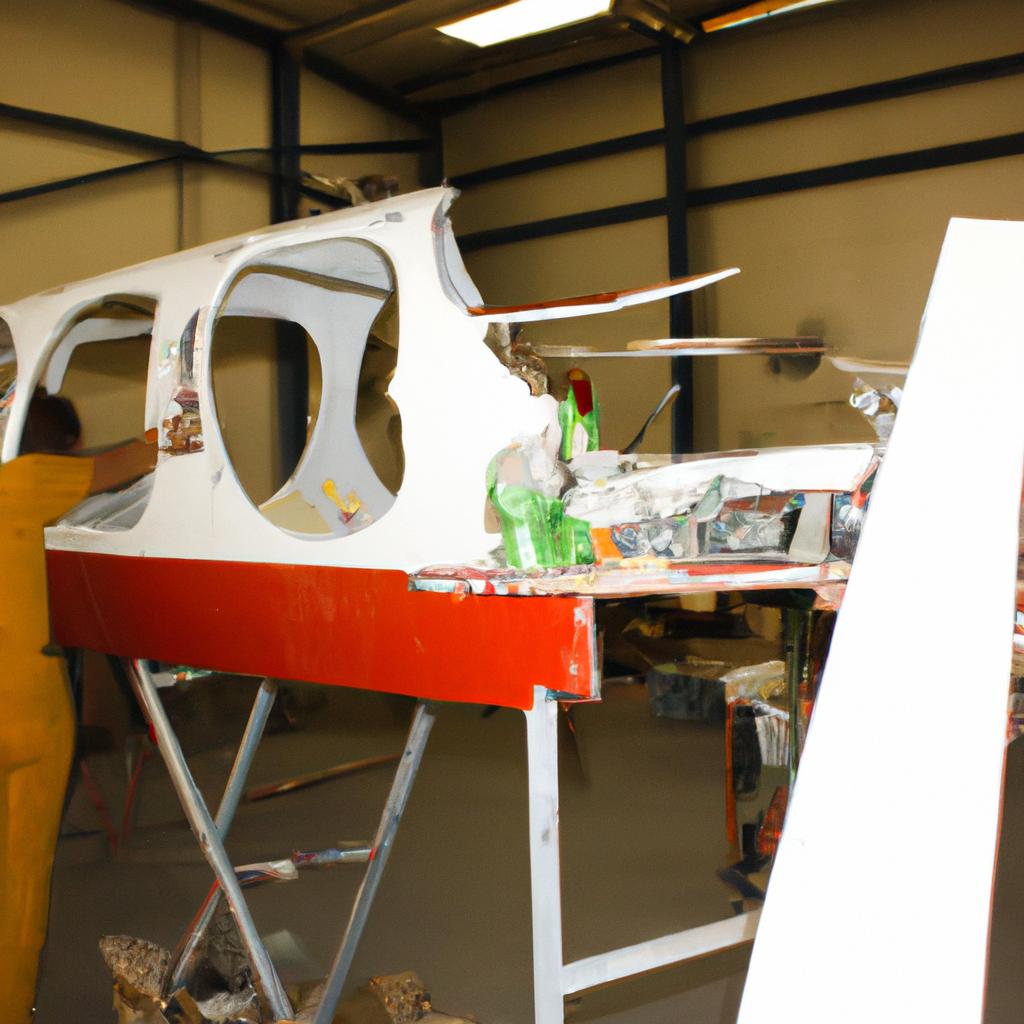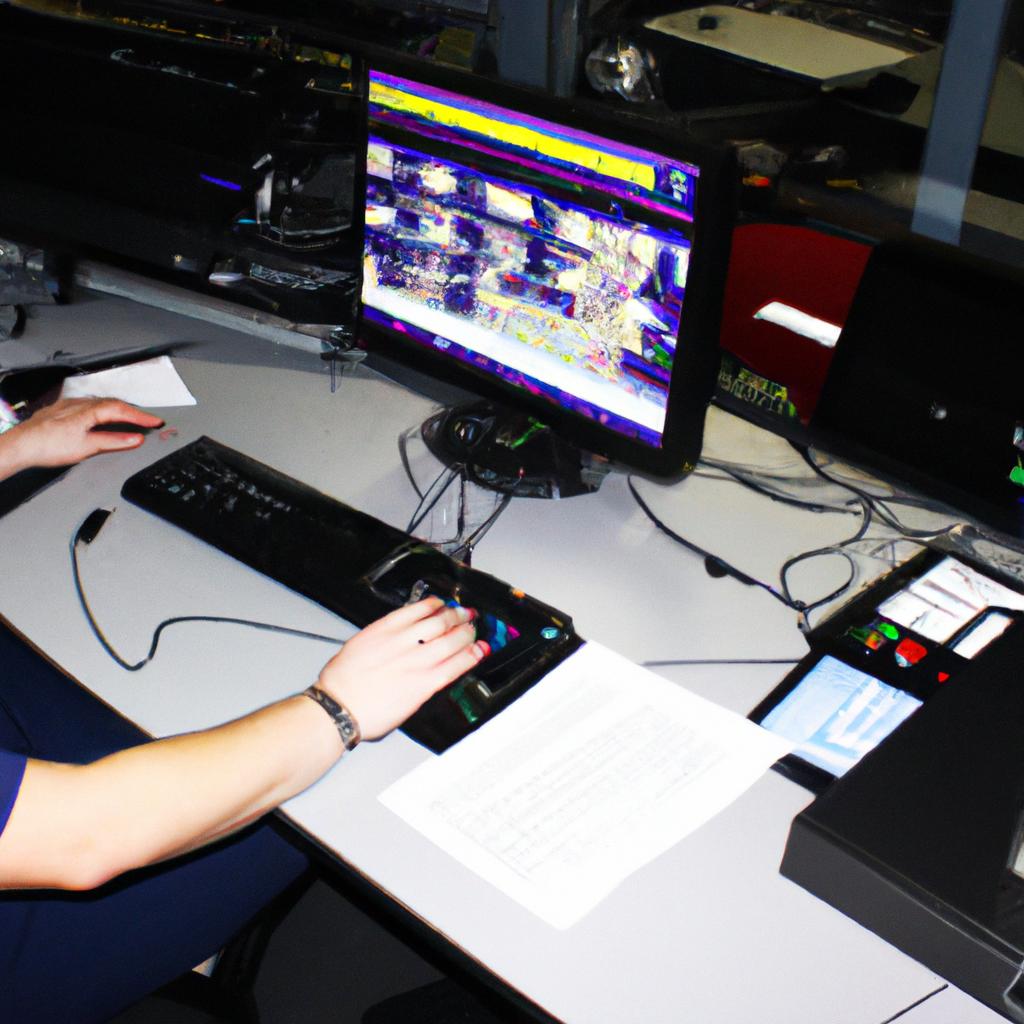The field of aviation safety in the aerospace and defense industry plays a crucial role in ensuring the protection of aircraft. With advancements in technology and an increasingly interconnected global landscape, it is imperative that measures are taken to mitigate risks and prevent accidents that may have catastrophic consequences. This article explores the various aspects involved in aviation safety, from comprehensive risk assessments to advanced monitoring systems, highlighting their significance in safeguarding aircraft.
One prominent example illustrating the importance of aviation safety is the case study of Malaysia Airlines Flight MH370. In March 2014, this flight disappeared while en route from Kuala Lumpur to Beijing, with all 239 passengers and crew members on board presumed dead. The incident revealed significant gaps in both communication protocols and tracking capabilities, prompting widespread discussions about enhancing aviation safety measures globally. Consequently, this tragic event served as a catalyst for renewed efforts to develop more robust systems aimed at preventing similar incidents and improving overall aircraft protection.
To address these concerns comprehensively, effective risk assessment methods are essential within the aerospace and defense industry. These assessments involve evaluating potential hazards associated with different stages of flight operations – including takeoff, cruising altitude, and landing – along with factors such as weather conditions, mechanical failures, human error, or external threats. By identifying potential risks through rigorous analysis and evaluation, aviation authorities and industry stakeholders can implement appropriate preventive measures to mitigate these risks.
In addition to risk assessment, advanced monitoring systems play a vital role in ensuring aviation safety. These systems utilize state-of-the-art technology to track and monitor aircraft during all phases of flight. For instance, Automatic Dependent Surveillance-Broadcast (ADS-B) is a surveillance technology that enables real-time tracking of aircraft positions using satellite-based navigation systems. By continuously broadcasting an aircraft’s GPS position, ADS-B enhances situational awareness for air traffic controllers and pilots, facilitating better communication and reducing the risk of collisions or other incidents.
Furthermore, sophisticated data analysis techniques are employed to identify patterns or anomalies that may indicate potential safety hazards. This involves processing vast amounts of data collected from various sources such as flight data recorders, maintenance logs, and pilot reports. By analyzing this data using artificial intelligence algorithms and predictive modeling, potential risks can be identified early on, allowing for proactive measures to be taken before accidents occur.
Enhancing communication protocols is another crucial aspect of aviation safety. Effective communication between pilots, air traffic controllers, maintenance personnel, and other stakeholders is essential for maintaining the integrity of flight operations. Clear and concise communication ensures that critical information is accurately transmitted and understood by all parties involved. Additionally, standardized procedures for reporting incidents or near-misses enable lessons learned to be shared across the industry, facilitating continuous improvement in safety practices.
Ultimately, the field of aviation safety continues to evolve as new technologies emerge and lessons are learned from past incidents. The aerospace and defense industry remains committed to implementing comprehensive risk assessments, advanced monitoring systems, enhanced communication protocols, and robust incident reporting mechanisms to ensure the protection of aircraft and passengers alike. Through these efforts, the industry strives to maintain the highest levels of safety standards while continually improving upon existing practices.
Importance of Aviation Safety
Aviation safety is an essential aspect in the aerospace and defense industry that cannot be underestimated. With millions of passengers relying on air transportation for both domestic and international travel, ensuring the protection of aircraft becomes paramount. To illustrate this point, let us consider a hypothetical scenario: imagine an airplane experiencing engine failure mid-flight, resulting in a life-threatening situation for all onboard. Such incidents highlight the critical importance of aviation safety measures to safeguard lives and prevent catastrophic accidents.
To further emphasize the significance of aviation safety, we can explore some key points:
-
Human Lives at Stake: The primary reason why aviation safety should be prioritized is due to the fact that human lives are involved. Each time an individual boards an aircraft, they place their trust in the hands of professionals responsible for maintaining safe operations. Any compromise in safety measures could potentially lead to devastating consequences.
-
Economic Impact: In addition to its impact on human lives, aviation safety also plays a crucial role in economic stability. Accidents or major incidents involving aircraft not only result in loss of lives but also have far-reaching implications on industries such as tourism and trade. Rebuilding trust after such events takes significant effort and resources.
-
Public Confidence: A robust aviation safety framework is necessary to maintain public confidence in air travel. Passengers need assurance that every possible measure has been taken to ensure their well-being during flights. Without this reassurance, individuals may hesitate to choose air transport as their preferred mode of travel.
Markdown bullet point list example:
- Human Lives at Stake
- Economic Impact
- Public Confidence
| Risk Factors | Potential Consequences | Preventive Measures |
|---|---|---|
| Technical | Aircraft malfunction | Regular maintenance |
| Environmental | Weather-related incidents | Enhanced monitoring |
| Operational | Pilot error | Stringent training |
| Security | Terrorist attacks | Robust security |
In conclusion, the importance of aviation safety cannot be overstated. With human lives at stake and significant economic consequences in case of accidents or incidents, it is imperative to maintain a strong focus on aircraft protection. In the following section, we will discuss regulatory measures that have been implemented to ensure comprehensive safety standards are met.
Moving forward, let us now examine the regulatory measures put in place for effective aircraft protection.
Regulatory Measures for Aircraft Protection
Having explored the importance of aviation safety, it is crucial to delve into the regulatory measures implemented to ensure aircraft protection. By examining these measures, we can gain insight into how the aerospace and defense industry works towards safeguarding passengers, crew members, and valuable assets on board. To illustrate this further, let us consider a hypothetical scenario where an airline experiences a security breach during flight.
In today’s aviation landscape, numerous regulations are in place to maintain high levels of safety and minimize potential risks associated with flying. These measures encompass various aspects that collectively contribute to ensuring robust aircraft protection. Some key elements include:
-
Stringent Screening Procedures:
- Pre-flight screening protocols are designed to identify potential threats before they have a chance to compromise aircraft security.
- Passengers undergo thorough checks, including baggage inspections and body scans, which help mitigate risks related to prohibited items or dangerous substances.
-
Enhanced Surveillance Systems:
- Advanced surveillance technologies such as closed-circuit television (CCTV) cameras and biometric scanners play a vital role in monitoring airport premises and identifying suspicious activities.
- Real-time monitoring helps detect anomalies and facilitates prompt responses when necessary.
-
Vigilant Crew Training:
- Flight crews receive rigorous training on emergency procedures, crisis management, threat assessment, and conflict resolution techniques.
- Their preparedness enables them to handle potentially dangerous situations effectively while prioritizing passenger safety.
-
Collaborative Intelligence Sharing:
- Governments, international organizations, airlines, and security agencies collaborate closely by sharing intelligence information regarding potential threats.
- This cooperation enhances situational awareness at all stages of air travel operations.
The table below provides examples of several global regulatory bodies responsible for ensuring aviation safety:
| Regulatory Body | Scope of Responsibility |
|---|---|
| Federal Aviation Administration (FAA) | United States’ civil aviation authority |
| International Civil Aviation Organization (ICAO) | Global coordination and regulation of aviation standards |
| European Union Aviation Safety Agency (EASA) | Ensuring harmonized safety regulations in Europe |
| Transport Canada | Overseeing aviation activities within Canada |
These regulatory measures, combined with ongoing technological advancements, pave the way for improved aircraft protection. In the subsequent section, we will explore how technology continually evolves to meet emerging safety challenges.
As we have seen, regulatory measures establish a foundation for robust aircraft protection. However, it is crucial to acknowledge that advancements in technology play a pivotal role in enhancing aviation safety. By harnessing innovative solutions, the aerospace and defense industry strives to address evolving risks effectively without compromising passenger well-being or operational efficiency.
Technology Advancements in Aviation Safety
Advances in technology have played a pivotal role in enhancing aviation safety. From innovative systems to sophisticated equipment, the aerospace and defense industry continuously seeks ways to improve aircraft protection. This section delves into some of the notable technological advancements that have contributed to the overall safety of aviation.
Technological Innovations:
One remarkable example is the development of collision avoidance systems. These cutting-edge technologies employ radar, GPS, and other sensors to detect nearby aircraft or obstacles, providing pilots with real-time alerts and guidance for evasive action. For instance, consider a hypothetical scenario where an airplane equipped with such a system detects another aircraft approaching from its blind spot. The collision avoidance system would promptly alert the pilot, enabling them to take immediate corrective measures and avoid a potential disaster.
To further illustrate how technology has revolutionized aviation safety, let us explore some key areas where advancements have made significant contributions:
- Enhanced cockpit displays: Modern aircraft now feature advanced flight deck displays that provide pilots with comprehensive situational awareness during all phases of flight.
- Improved communication systems: High-speed data links and satellite-based communications enable seamless exchange of critical information between air traffic control (ATC) centers and airplanes.
- State-of-the-art surveillance techniques: Advanced surveillance technologies like Automatic Dependent Surveillance-Broadcast (ADS-B) enhance visibility by accurately broadcasting an aircraft’s position and intention.
- Efficient weather monitoring tools: Sophisticated meteorological instruments allow pilots to anticipate adverse weather conditions well in advance, ensuring appropriate course adjustments are made.
Emphasizing the importance of these advancements, below is an emotional appeal highlighting their impact on aviation safety:
Advancements in Technology Saving Lives
Increased situational awareness
Real-time communication capabilities
Enhanced aircraft visibility
Early detection of hazardous weather
| Advances in Technology | Impact on Aviation Safety |
|---|---|
| Increased Situational Awareness | Reduction in mid-air collisions |
| Real-time Communication Capabilities | Swift response to emergencies |
| Enhanced Aircraft Visibility | Decreased risk of runway incursions |
| Early Detection of Hazardous Weather | Prevention of weather-related accidents |
These technological advancements have undoubtedly transformed the aviation industry, ensuring safer journeys for passengers and crew alike. As we move forward, it is crucial to continue investing in research and development to further enhance aircraft protection. The subsequent section will explore another critical aspect in this endeavor: training and education for aviation professionals.
Transition into next section:
As technology continues to evolve, equipping aviation professionals with the necessary skills becomes increasingly important. Training and education play a fundamental role in maintaining the highest standards of safety within the aerospace and defense sector.
Training and Education for Aviation Professionals
By equipping individuals with comprehensive knowledge and skills, we can ensure that aircraft protection remains at the forefront.
Training and education play a vital role in maintaining aviation safety standards. For instance, consider a hypothetical scenario where an airline pilot encounters adverse weather conditions during flight. Through rigorous training programs, pilots are prepared to handle such situations effectively, employing their expertise to navigate through challenging circumstances while prioritizing passenger safety.
To further emphasize the significance of training and education in aviation safety, let us delve into four key areas:
- Standard Operating Procedures (SOPs): Aviation professionals undergo extensive training to familiarize themselves with SOPs tailored to specific aircraft types and operations. Following these standardized procedures ensures consistency across all flights and minimizes human error risks.
- Emergency Response Training: Airlines conduct regular emergency response drills to train cabin crew members in handling various critical scenarios like evacuations or medical emergencies. This systematic preparation enables them to respond swiftly and efficiently when faced with unexpected events.
- Human Factors Training: Recognizing the impact of human factors on aviation safety is essential. Education surrounding topics like fatigue management, situational awareness, and decision-making helps professionals understand how psychological aspects influence performance and enables them to mitigate associated risks.
- Technology Integration Training: As technology continues to evolve within aerospace and defense industries, it becomes imperative for aviation professionals to receive adequate training on new systems and equipment integration. Such training empowers them to utilize advanced technologies optimally, enhancing overall operational efficiency.
In addition to these key areas of focus, it is worth highlighting some benefits that stem from investing in comprehensive training programs for aviation professionals:
| Benefits |
|---|
| Enhanced Confidence |
| Efficient Crisis Management |
By prioritizing training and education, the aviation industry can foster a culture of continuous improvement and adaptability. This approach ensures that professionals are well-equipped to handle evolving challenges while upholding high safety standards.
As we have explored how training and education contribute significantly to aviation safety, the subsequent section will delve into the critical aspect of risk assessment and management in aerospace and defense, further solidifying our understanding of comprehensive aircraft protection measures.
Risk Assessment and Management in Aerospace and Defense
Building upon a strong foundation of training and education, aviation professionals must also be equipped with effective risk assessment and management strategies to ensure the safety of aircraft. By proactively identifying potential hazards and implementing mitigation measures, aerospace and defense organizations can minimize risks and enhance overall safety.
Risk Assessment:
One example that highlights the importance of risk assessment is the case of an international airline facing operational challenges due to adverse weather conditions. Through meticulous analysis of meteorological data, including wind patterns, temperatures, precipitation levels, and visibility measurements, the airline’s risk management team was able to identify areas prone to severe turbulence. This information allowed them to adjust flight routes accordingly, ensuring passenger safety while minimizing disruptions caused by unexpected atmospheric disturbances.
To effectively manage risks associated with aviation operations, it is crucial for organizations to adopt comprehensive risk assessment practices. This involves:
- Conducting thorough analyses of both internal (e.g., technical failures) and external factors (e.g., weather conditions).
- Utilizing advanced modeling techniques to forecast potential threats.
- Implementing proactive measures such as regular maintenance checks or pilot proficiency assessments.
- Establishing contingency plans to address unforeseen events during flights.
Table: Emotional Response Evoking Factors
| Factor | Description |
|---|---|
| Human Lives | Prioritizing the well-being of passengers |
| Environmental | Minimizing ecological impact |
| Economic | Reducing costs associated with accidents |
| Reputation | Safeguarding public trust |
Collaboration among Key Stakeholders:
In addition to robust risk assessment practices, collaboration among key stakeholders plays a vital role in enhancing aviation safety. An open exchange of information between regulatory bodies, airlines, manufacturers, and maintenance organizations enables a comprehensive understanding of potential risks. By sharing incident data, lessons learned, and best practices across the industry, collective knowledge can be leveraged to identify common patterns or systemic vulnerabilities that may affect aircraft safety.
By proactively collaborating in this manner, aviation professionals can work together to develop innovative solutions aimed at minimizing risks and enhancing overall safety standards. This collaborative approach fosters an environment where every stakeholder is committed to continuous improvement and the shared goal of safeguarding human lives, protecting the environment, preserving economic interests, and upholding reputational integrity.
Transition into the subsequent section:
To further strengthen aviation safety measures, collaboration and information sharing are essential components that foster enhanced awareness and response capabilities among aerospace and defense organizations. By pooling resources and expertise from various stakeholders, critical insights can be gained to mitigate emerging risks effectively.
Collaboration and Information Sharing for Enhanced Safety
Having examined the importance of risk assessment and management in aerospace and defense, we now turn our attention to another crucial aspect of aviation safety – collaboration and information sharing. By fostering a culture of cooperation among industry stakeholders, including government agencies, manufacturers, airlines, and regulatory bodies, enhanced safety measures can be implemented to further protect aircraft from potential threats.
Section:
One illustrative example highlighting the significance of collaboration is the Joint Authorities Technical Review (JATR) formed by various international civil aviation authorities following the two fatal accidents involving Boeing 737 MAX aircraft. This collaborative effort aimed to conduct an independent review of the design certification processes associated with these incidents. Through collective expertise and shared insights, JATR successfully identified areas requiring improvement within both the manufacturer’s internal processes and regulatory oversight systems. Such collaborations are instrumental in addressing vulnerabilities that may compromise flight safety.
To emphasize the impact of effective collaboration on aviation safety, consider the following emotional response-evoking bullet points:
- Increased transparency through data-sharing enhances trust between stakeholders.
- Timely exchange of critical information allows for swift identification and mitigation of risks.
- Collaborative efforts facilitate the development of standardized practices across industries.
- Shared resources enable more comprehensive research into emerging technologies or potential threats.
Table: Stakeholder Collaboration Matrix
| Stakeholders | Role | Benefit |
|---|---|---|
| Government Agencies | Regulatory oversight | Efficient enforcement |
| Manufacturers | Designing safe aircraft | Improved product reliability |
| Airlines | Implementing operational procedures | Enhanced crew training |
| Regulatory Bodies | Setting standards | Consistent compliance |
By analyzing this matrix, it becomes evident that when different stakeholders work together, their collective efforts result in a safer aviation ecosystem. The collaboration facilitates streamlined operations and ensures that aircraft protection remains at the forefront of industry priorities.
In light of the importance of collaboration for enhanced safety, it is crucial to recognize its ongoing role in shaping the future of aerospace and defense. By fostering an environment where information sharing is encouraged and stakeholders work hand-in-hand towards common goals, we can continue to improve aviation safety measures and protect both passengers and crew alike.
 Louth Online
Louth Online



